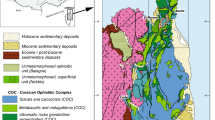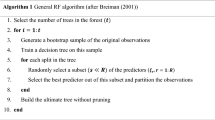Abstract
Realization of large geo-engineering projects in rocks containing naturally occurring asbestos (NOA) must address several crucial geo-environmental issues, including the design of the construction site, the enforcement of health protection measures and the environmentally responsible spoil management. This leads to a compelling need to develop effective and standard procedures to evaluate the distribution and concentration of NOA in rock volumes. NOA petrofacies are here proposed as an innovative tool to evaluate the asbestos distribution and concentration in complex geological settings. NOA petrofacies are fundamental asbestos-bearing rock types, consisting in recurrent lithological and structural features controlling asbestos occurrence. Here we describe and discuss how the NOA petrofacies approach was utilized in a geo-environmental study for the evaluation of asbestos content in a complex meta-ophiolite suite, which will be crossed by the “Gronda di Genova” highway by-pass project (Genoa, NW Italy). NOA petrofacies were used to predict the distribution and relative abundance of NOA in geologically homogeneous zones characterized by the occurrence of specific NOA minerals.














Similar content being viewed by others
Notes
In the photomicrographs (as well as in the text), the mineral abbreviations are after Whitney and Evans (2010), except for Mg-Chl = Mg-rich chlorite. Where the microstructural features of serpentinite allowed recognition of the original peridotite mineral this has been labelled as (Ol) in case of mesh structure after olivine and as (Opx) for bastite pseudomorphs after orthopyroxene.
References
Andreani M, Boullier AM, Gratier JP (2005) Development of schistosity by dissolution-crystallization in a Californian serpentinite gouge. J Struct Geol 27:2256–2267
ASPI — Autostrade per l’Italia, Centro Scansetti — Interdepartmental Center for Studies on Asbestos and Other Toxic Particulates of the University of Torino (2011a) Studio relativo alla presenza di amianto naturale — Relazione Centro Scansetti, Nodo Stradale ed Autostradale di Genova, GEO0179 [Study on the occurrence of natural asbestos; in Italian]. Available online at http://www.va.minambiente.it/it-IT/Oggetti/Documentazione/427/495?Testo=GEO0179&RaggruppamentoID=&x=0&y=0
ASPI — Autostrade per l’Italia, Centro Scansetti — Interdepartmental Center for Studies on Asbestos and Other Toxic Particulates of the University of Torino (2011b) Linee guida per la gestione delle terre e rocce da scavo, Nodo Stradale ed Autostradale di Genova, APG0004-1 [Guidelines for the management of spoils; in Italian]. Available online at http://www.va.minambiente.it/it-IT/Oggetti/Documentazione/427/495?Testo=APG0004
Auzende AL, Daniel I, Reynard B, Lemaire C, Guyot F (2004) High-pressure behaviour of serpentine minerals: a Raman spectroscopic study. Phys Chem Miner 31:269–277
Barale L, Piana F, Compagnoni R, Tallone S, Avataneo C, Botta S, Irace A, Marcelli I, Cossio R, Mosca P, Turci F (submitted) Geological model for NOA content prediction in the rock excavation of a long tunnel (‘Gronda di Genova’ project - NW Italy). Environ Engin Geosci
Bellopede R, Clerici C, Marini P, Zanetti G (2009) Rocks with asbestos: risk evaluation by means of mechanical abrasion test. Am J Environ Sci 5:500–506
Bernoulli D, Caron C, Homewood P, Kӓlin O, van Stuijvenberg J (1979) Evolution of continental margins in the Alps. Schweiz Mineral Petrogr Mitt 59:165–170
Bloise A, Punturo R, Catalano M, Miriello D, Cirrincione R (2016) Naturally occurring asbestos (NOA) in rock and soil and relation with human activities: the monitoring example of selected sites in Calabria (southern Italy). Ital J Geosci 135(2):268–279
Bloise A, Catalano M, Critelli T, Apollaro C, Miriello D (2017) Naturally occurring asbestos: potential for human exposure, San Severino Lucano (Basilicata, Southern Italy). Environ Earth Sci 76:648
Capponi G, Crispini L (2008) Carta Geologica d’Italia alla scala 1.50.000 e Note Illustrative. Foglio 213-230 (Genova). APAT, Roma
Carbone M, Kanodia S, Chao A, Miller A et al (2016) Consensus report of the 2015 Weinman international conference on mesothelioma. J Thorac Oncol 11(8:1246–1262
Compagnoni R, Groppo C (2006) Gli amianti in Val di Susa e le rocce che li contengono. Rend Soc Geol Ital 3:21–28
Compagnoni R, Sandrone R, Zucchetti S (1980) Some remarks on the asbestos occurrences in the Western Alps, with special reference to the chrysotile asbestos deposit of Balangero (Lanzo Valley, Piedmont, Italy). In: 4th international conference on Asbestos, Torino, 26-30 May 1980, pre-prints, vol 1, pp 49–71
Cortesogno L, Haccard D (1984) Note illustrative alla carta geologica della zona Sestri-Voltaggio. Mem Soc Geol Ital 28:115–150
Crispini L, Federico L, Capponi G, Spagnolo C (2009) Late orogenic transpressional tectonics in the “Ligurian knot”. Ital J Geosci 128:433–441
Elter P, Pertusati P (1973) Considerazioni sul limite Alpi – Appennino e sulle sue relazioni con l’arco delle Alpi Occidentali. Mem Soc Geol Ital 12:359–376
Evans BW (1977) Metamorphism of alpine peridotites and serpentinites. Annu Rev Earth Planet Sci 5:397–447
Federico L, Capponi G, Crispini L, Scambelluri M (2004) Exhumation of alpine high pressure rocks: insights from petrology of eclogite clasts in the tertiary Piedmontese basin (Ligurian Alps, Italy). Lithos 74:21–40
Frezzotti ML (2001) Applicazione della microspettroscopia Raman agli studi di mineralogia e petrologia. Plinius 26:62–73
Giacomini F, Boerio V, Polattini S, Tiepolo M, Tribuzio R, Zanetti A (2010) Evaluating asbestos fibre concentration in metaophiolites: a case study from the Voltri massif and Sestri-Voltaggio zone (Liguria, NW Italy). Environ Earth Sci 61:1621–1639
Groppo C, Compagnoni R (2007) Ubiquitous fibrous antigorite veins from the Lanzo ultramafic massif, Western Alps. Per Mineral 76:169–181
Groppo C, Rinaudo C, Cairo S, Gastaldi D, Compagnoni R (2006) Micro-Raman spectroscopy for a quick and reliable identification of serpentine minerals from ultramafics. Eur J Mineral 18:319–329
Harper M (2008) 10th anniversary critical review: naturally occurring asbestos. J Environ Monit 10:1394–1408
Hendrickx M (2009) Naturally occurring asbestos in eastern Australia: a review of geological occurrence, disturbance and mesothelioma risk. Environ Geol 57:909–926
Hoogerduijn Strating EH (1994) Extensional faulting in an intraoceanic subduction complex – working hypothesis for the Paleogene of the Alps-Apennine system. Tectonophysics 238:255–273
Hoogerduijn Strating EH, Vissers RLM (1994) Structures in natural serpentinite gouges. J Struct Geol 16:1205–1215
IARC — International Agency for Research on Cancer (2012) A review of human carcinogens. Part C: arsenic, metals, fibres and dust. IARC monographs on the evaluation of carcinogenic risks to humans. IARC, Lyon. Available online at https://monographs.iarc.fr/iarc-monographs-on-the-evaluation-of-carcinogenic-risks-to-humans-19/&sa=D&ust=1549271690605000&usg=AFQjCNFGnLHOTbyKi-e-ZM4_wP87taT5eQ
Karkanas P (1995) The slip-fiber chrysotile asbestos deposit in the Zidani area, northern Greece. Ore Geol Rev 10:19–29
Labagnara D, Patrucco M, Rossetti P, Pellegrino V (2013) Predictive assessment of asbestos content in the Western Italian Alps: an essential tool for an effective approach to risk analysis in tunneling operations and muck reuse. Environ Earth Sci 70:857–868
Lahondère D, Cagnard F, Wille G, Duron J, Misseri M (2018) TEM and FESEM characterization of asbestiform and non-asbestiform actinolite fibers in hydrothermally altered dolerites (France). Environ Earth Sci 77:385
Lemaire C, Guyot F, Reynard B (1999) Vibrational spectroscopy (IR and Raman) of OH groups in chrysotile, lizardite and antigorite. J Conf Abstr 4:654
Lescano L, Marfil S, Maiza P, Sfragulla J, Bonalumi A (2013) Amphibole in vermiculite mined in Argentina. Morphology, quantitative and chemical studies on the different phases of production and their environmental impact. Environ Earth Sci 70:1809–1821
Lombardo B, Nervo R, Compagnoni R, Messiga B, Kienast JR, Mevel M, Martin S, Tartarotti P, Dal Piaz GV (1994) The Mesozoic ophiolites of the Alps: a review. Boll Geofis Teor Appl 36:175–219
Petriglieri JR, Salvioli-Mariani E, Mantovani L, Tribaudino M, Lottici PP, Laporte-Magoni C, Bersani D (2014) Micro-Raman mapping of the polymorphs of serpentine. J Raman Spectrosc 46:953–958
Petriglieri JR, Laporte-Magoni C, Gunkel-Grillon P, Tribaudino M, Bersani D, Sala O, Le Mestre M, Vigliaturo R, Bursi Gandolfi N, Salvioli-Mariani E (2019) Mineral fibers and environmental monitoring: a comparison of different analytical strategies in New Caledonia. Geosci Front. https://doi.org/10.1016/j.gsf.2018.11.006
Piana F, Fioraso G, Irace A, Mosca P, d’Atri A, Barale L, Falletti P, Monegato G, Morelli M, Tallone S, Vigna GB (2017) Geology of Piemonte region (NW Italy, Alps-Apennines interference zone). J Maps 13:395–405
Rinaudo C, Gastaldi D, Belluso E (2003) Characterization of chrysotile, antigorite and lizardite by FT-Raman spectroscopy. Can Mineral 41:883–890
Ross M, Nolan RP (2003) History of asbestos discovery and use and asbestos-related disease in context with the occurrence of asbestos within ophiolite complexes. Geol Soc Am Spec Pap 373:447–470
Turci F, Compagnoni R, Piana F, Delle Piane L, Tomatis M, Fubini B, Tallone S, Fuoco S, Bergamini M (2015) Geological and analytical procedures for the evaluation of asbestos-related risk in underground and surface rock excavation. In: Lollino G et al (eds) Engineering geology for society and territory - volume 5. Springer, Berlin
Turci F, Favero-Longo SE, Gazzano C, Tomatis M, Gentile-Garofalo L, Bergamini M (2016) Assessment of asbestos exposure during a simulated agricultural activity in the proximity of the former asbestos mine of Balangero, Italy. J Hazard Mater 308:321–327
Van Gosen BS (2007) The geology of asbestos in the United States and its practical applications. Environ Eng Geosci 13:55–68
Vignaroli G, Rossetti F, Belardi G, Billi A (2011) Linking rock fabric to fibrous mineralisation: a basic tool for the asbestos hazard. Nat Hazards Earth Syst Sci 11:1267–1280
Vignaroli G, Belardi G, Serracino M (2013) Multi-scale geological evaluation for quarrying activities in ophiolitic rocks: implications for asbestos-related legislation. Bull Eng Geol Environ 72:285–302
Vignaroli G, Ballirano P, Belardi G, Rossetti F (2014) Asbestos fibre identification vs. evaluation of asbestos hazard in ophiolitic rock mélanges, a case study from the Ligurian Alps (Italy). Environ Earth Sci 72:3679–3698
Whitney DL, Evans BW (2010) Abbreviations for names of rock-forming minerals. Am Mineral 95:185–187
Acknowledgements
This work was developed for setting up the geo-environmental model of the “Gronda di Genova” working plan [highway by-pass of Genoa city, Italy, designed by Autostrade per l’Italia, Rome (ASPI)], commissioned by Spea Engineering spa, Milan (Italy) to a consortium comprising the “G.Scansetti” Interdepartmental Center for Studies on Asbestos and Other Toxic Particulates of the University of Torino (Italy), the Institute of Geosciences and Earth Resources of the National Research Council of Italy, Torino, and Gi-RES srl (a CNR spin-off company), Torino, under the contract no. 400006258/2018.
The Authors are indebted to Girolamo Belardi, Daniele Passeri and Francesca Trapasso (CNR-IGAG - Institute of Environmental Geology and Geoengineering, Roma) for designing and performing comminution of the samples. A research paper on this last complex and unexplored subject is being currently prepared.
Francesco Cipolli (Spea Engineering, Genova), Vittorio Boerio and Simona Polattini (Spea Engineering, Milano) are kindly acknowledged for their continuous support and feedback throughout all working stages.
Two anonymous reviewers are thanked for their helpful suggestions.
Author information
Authors and Affiliations
Corresponding author
Electronic supplementary material
Online Resource 1
In the spreadsheet are listed the analyzed samples grouped into NOA petrofacies. The NOA concentration column (marked with a different color for each petrofacies) reports values obtained by SEM-EDS analyses expressed in mg/Kg for all samples, apart from those whose asbestos content is under the limit of detection (<LOD) of the used technique. The NOA concentration values in bold are those over the Italian law threshold of 1000 mg/kg. The asbestos amount has to be read “concentration ± error”; the error is not defined for samples in which less than 30 fibers were found. The number of explored fields is normally 100 (total explored area around 1 mm2) apart from some exceptions very rich in fibers. The last two columns report the % of asbestos due to chrysotile/fibrous antigorite or tremolite-actinolite amphibole occurrence. (XLSX 122 kb)
Rights and permissions
About this article
Cite this article
Botta, S., Avataneo, C., Barale, L. et al. Petrofacies for the prediction of NOA content in rocks: application to the “Gronda di Genova” tunneling project. Bull Eng Geol Environ 79, 185–204 (2020). https://doi.org/10.1007/s10064-019-01539-6
Received:
Accepted:
Published:
Issue Date:
DOI: https://doi.org/10.1007/s10064-019-01539-6




